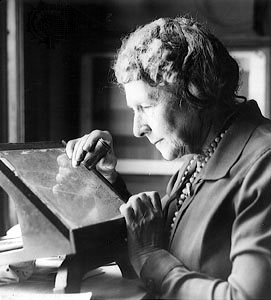Cannon, Annie Jump (1863–1941)

Annie Jump Cannon was an American astronomer who compiled the enormously influential Henry Draper Catalogue. Cannon was introduced to astronomy by her mother, studied physics at Wellesley College, and specialized in astronomy at Radcliffe College. In 1896 she was appointed by Edward Pickering to the staff at Harvard College Observatory, where she began to study variable stars and stellar spectra. As color film was not yet available, classification had to be done, tediously and with great difficulty, by eye.
In 1901 she published a catalogue of 1,122 southern stars, which represented a sequence of continuous change from the blue-white stars of types O and B, with their strong helium lines, through types A, F, G, and K, characterized hydrogen and various metal lines, to the red stars of type M with their spectral bands of titanium and carbon oxides. It was not known at the time that this was a temperature sequence. In 1910, her scheme was adopted by all observatories.
Then came her most famous work, the Henry Draper Catalogue, published by the Harvard Observatory between 1918 and 1924, which lists the spectral types, magnitudes, and positions of 225,300 stars, down to ninth magnitude – every one classified by Cannon in person. In 1922, her system was adopted by the International Astronomical Union as the official system for the classification of stellar spectra. She then continued the study down to eleventh magnitude and, in the process, discovered 277 variable stars and 5 novae.
Among the many honors she received internationally for her work, was the first honorary PhD to be granted to a woman by Oxford University.


